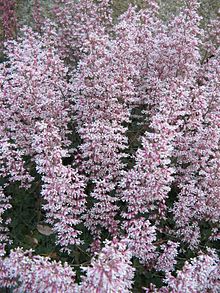Heuchera
| Heuchera | |
|---|---|
 |
|
| Heuchera elegans on Mount Wilson in California | |
| Scientific classification | |
| Kingdom: | Plantae |
| (unranked): | Angiosperms |
| (unranked): | Eudicots |
| (unranked): | Core eudicots |
| Order: | Saxifragales |
| Family: | Saxifragaceae |
| Genus: |
Heuchera L. |
| Species | |
|
See text |
|
See text
Heuchera /ˈhjuːkᵻrə/ is a genus of evergreen, herbaceous perennial plants in the family Saxifragaceae, all native to North America. Common names include alumroot and coral bells. They have palmately lobed leaves on long petioles, and a thick, woody . The genus was named after Johann Heinrich von Heucher (1677–1746), an 18th-century German physician, and Professor at Wittenberg University. There are approximately 37 species, but the taxonomy of the genus is difficult because the species often intergrade with one another, hybridization is common, and the flowers change markedly in proportion as they develop.
Alumroot species grow in varied habitats, so some species look quite different from one another, and have varying preferences regarding temperature, soil, and other natural factors. H. maxima is found on the Channel Islands of California, where it grows on rocky, windy, saline-washed ocean shores, and H. sanguinea, called coral bells because of its cerise flowers, can be found in the warm, dry canyons of Mexico and adjacent New Mexico and Arizona.
Several alumroots and their crosses are used as ornamental plants.
Native American peoples used some Heuchera species medicinally. The Tlingit used H. glabra as an herbal remedy for inflammation of the testicles caused by syphilis. To the Navajo, H. novamexicana was a panacea and a pain reliever. The roots of H. cylindrica had a variety of medicinal uses among the Blackfoot, Flathead, Kutenai, Okanagan, Colville, and Shuswap.
...
Wikipedia
